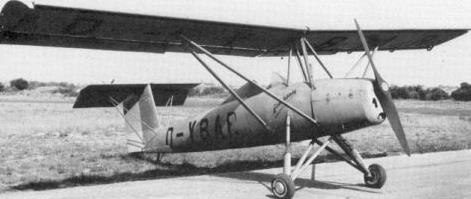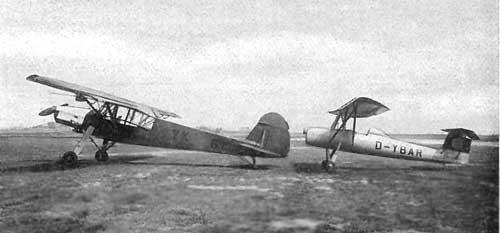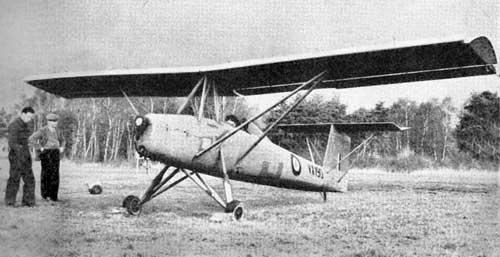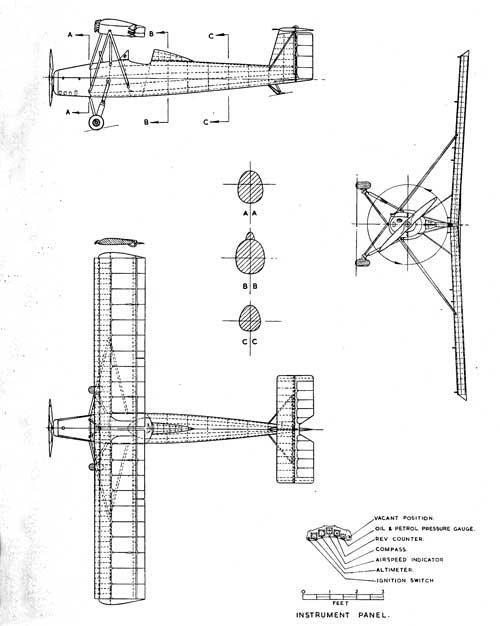The LF-1 was designed by Prof. Dr.-Ing. Hermann Winter and some of his students from the Technische Universität Braunschweig.
The LF-1 is a parasol wing monoplane with a high-set tailplane, powered by a Zündapp Z 9-092 engine delivering 37 kW (50 hp), able to operate from a 100 m (330 ft) airstrip. The two-piece wings are set at 16° dihedral and are supported by a pair of v cabane struts and v-struts either side from approx half-span to the lower centre fuselage. Full span leading edge slats extend automatically and full span trailing edge flaps / drooping ailerons can be extended manually by the pilot. The fixed tailwheel undercarriage attaches to the fuselage with long struts and oleo pneumatic shock absorbers.
It was a proof-of-concept design for a 'fool-proof' trainer intended for novice pilots with only one hour of ground instruction, the hour being reduced to five-minutes for those who had already flown gliders, and was intended to be impossible to either stall or spin.
.The Zaunkönig registration D-YBAR was taken to the Royal Aircraft Establishment (RAE) at Farnborough for slow flying tests; given the British serial VX190., where amongst others, it was flown by Eric "Winkle" Brown CO Aero Flight, the aircraft also being soloed by the then-head of the RAE Aerodynamics Section, Handel Davies, whose previous experience was as a pupil in a dual-control Miles Magister, after a half-hour of ground instruction. It was sold to a British private owner in June 1949 as G-ALUA, and then to the Experimental Flying Group and to the Ultra Light Aircraft Association, subsequently in 1974 to an Irish owner, being registered EI-AYU, returning to Germany, in 1976, as D-EBCQ. As of 2008, it was preserved in the Deutsches Museum collection at Oberschleissheim near Munich.
Encouraged by the positive British reviews Prof. Ing. Hermann Winter decided to build a third LF-1. The construction started in 1954 and it was the first new aircraft in Germany after the war to receive a certificate by the Luftfahrt-Bundesamt (LBA) in Braunschweig and the code D-EBAR. Winter envisioned the Zaunkönig as a People's Aircraft affordable for all (for a price of around DM 6,000). On 28 April 1957, the wartime Luftwaffe fighter ace Heinrich Bär was conducting a routine flight check in the D-EBAR. Bär put the aircraft into a flat spin, the final manoeuvre in the test process at Braunschweig-Waggum. The aircraft spun down to 50 m (160 ft) then, unable to regain control, it crashed and Bär received fatal head injuries.
The aircraft was damaged beyond repair and written off.
At the time a fourth LF-1 V4 was already under construction and it flew a few months after the fatal accident with the V3. It received its certificate in 1958 and the code D-ECER. This aircraft flew for some years in Germany until grounded after the death of Prof. Ing. Winter in 1968. It was restored in 1980 and flew until 1999 as D-EBCG and as of 2008 preserved in the collection of the Internationals Luftfahrtmuseum Manfred Pflumm near Villingen-Schwenningen
| Type |
Single seat light sportplane |
| Engine |
1 Zündapp Z9-092 50 hp, two-blade wooden prop. dia. 1,8 m |
| Dimensions |
Length 6,08 m, height 2,38 m, span 8,02 m, wing area 8,5 m2 |
| Weights |
Empty 253 kg, flying weight 370 kg, fuel capacity 40 l, oil 3,5 l |
| Performance |
Max. speed 141 km/h, cruising speed 125 km/h, landing speed 46 km/h, range 450 km, service ceiling 3820 m, climb 2,85 m/sec., time to 1000 m 6 min. 42 sec. |
| Type |
Werk.Nr |
Registration |
History |
| V1 |
|
D-YBAR |
Work on the prototype began mid-1940 and powered by a 51 hp Zündapp 9-092 engine and registered D-YBAR, it was first flown by Professor Winter on December 17, 1940. The flight characteristics revealed a good-natured behavior, while the flight performance confirmed the expectations with a stall speed of 29.2 mph (47 kmh) and a maximum speed in level flight of 87.6 mph (141 kmh). But not all test flights went smoothly, on May 25, 1941, the aircraft made a forced landing in woods, due to flutter at a speed far above the maximum level speed. The aircraft was damaged, but Professor Winter escaped serious injuries. The aircraft was determine the roll speed of the aircraft, a second serious accident occurred. During the flight tests, performed by repaired and flown again on July 16, 1941, however, on September 11, 1942, during a flight to determine the roll speed of the aircraft, a second serious accident occurred. During the flight tests, performed by the assistant Franz Glatz, there was an overload of the lateral control system, which then failed. This led to the flapping of the wings and subsequently the loss of the right wing. The pilot managed to parachute to safety, the plane crashed onto a truck parked on the parade ground in Brunswick, and both the aircraft and the truck were a total loss. |
| V2 |
|
D-YBAR |
A second test aircraft, the LF 1 V2 was built, which completed its first flight in May 1943, once again registered D-YBAR. The type was named Zaunkönig (Wren) on February 5, 1944.he aircraft was tested for military applications and was once even armed with a Panzerfaust 100 recoilless anti-tank weapon. The aircraft survived WW II, but shortly before the occupation of the Technische Hochschule Braunschweig by Allied troops in April 1945, all aircraft documentation was destroyed. The Zaunkönig was transferred to the RAE at Farnborough in the UK, serialed VX190, and flown by a number of test pilots, including the well-known Captain Eric 'Winkle' Brown. |













